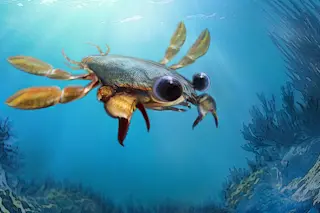Reconstruction of ancient crab called Calichimaera perplexa. (Credits: Oksana Vernygora, University of Alberta) (Inside Science) -- A newfound fossil that scientists described as perplexing, beautiful and the platypus of the crab family is now shedding light on how its crustacean relatives evolved, a new study finds. Paleontologists examined more than 70 exceptionally well-preserved specimens of the entirely new branch of the crab evolutionary tree, along with hundreds of fossils of shrimp and other kinds of crustaceans, from deposits in Colombia and the United States that are 90 million to 95 million years old, dating back to the Cretaceous Period. They named the new species Callichimaera perplexa, which translates into "perplexing beautiful chimera." Like the mythical chimera, which combines features from a lion, goat and snake into one body, C. perplexa combines traits from several extinct and living crabs, and from different life stages of crabs. For example, its long body, ...
'Perplexing' New Crab Species Sheds Light on Crustacean Evolution
Discover the fascinating Calichimaera perplexa, an ancient crab with a unique mosaic of features, revealing insights into crab evolution.
More on Discover
Stay Curious
SubscribeTo The Magazine
Save up to 40% off the cover price when you subscribe to Discover magazine.
Subscribe













